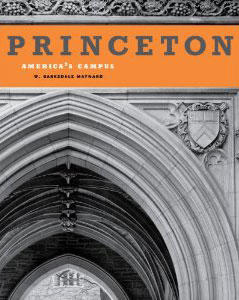Q&A with W. Barksdale Maynard '88, author of Princeton: America's Campus
Author of Princeton: America’s Campus
“You could teach the whole history of American architecture using the Princeton campus.”
It was a little embarrassing to W. Barksdale Maynard ’88 that Harvard, Yale, and other universities had lengthy, scholarly architectural histories while Princeton had none. Maynard, who taught a one-time course through the art and archaeology department in 2008 on Princeton’s campus architecture, decided he would fill that gap. In Princeton: America’s Campus (Penn State University Press), Maynard uses text and rare archival photographs to provide a history of Princeton’s campus interwoven with a social history of the University. A PAW contributor and the author of five books, including Woodrow Wilson: Princeton to the Presidency and Architecture in the United States, 1800-1850, Maynard spoke with Katherine Federici Greenwood.
When you first came to campus, what struck you about Princeton’s architecture?
I remember approaching Nassau Hall and it was dark and gloomy and Colonial and awe-inspiring, and then around the back of Nassau Hall are these two gleaming white Greek temples. I just thought that was astounding. … And immediately [I] was curious. Who thought that was a good idea to combine all these different styles with no regard for how they interact with each other? This is what makes Princeton remarkable – that in a sense it’s not unified, it’s not like Stanford, for example, where it’s all one style. It’s polyglot and incredibly interesting for that reason.
Which era in Princeton’s history produced the best results in terms of enhancing the physical beauty of the campus?
There is no question that our campus is the finest collection of Collegiate Gothic I would say in the world outside of England. Yale might dispute that. But we were first – Yale copied us. And it struck me in writing the book [that] every architect I talked to, no matter how diehard a modernist, [said] that Holder Hall and the Gothic is just perfect at Princeton. It’s just spectacular. Everyone loves it.
What was the most surprising thing you found as you worked on the book?
I was amazed at how little we actually knew about the [history of the] campus and especially in some really critical moments. For example, the involvement of Ralph Adams Cram. … Princeton is his masterpiece because he gave us the blueprint for the Gothic. He didn’t design all those Gothic dorms, but he designed Campbell Hall and planned all the rest of them. And he gave us the Chapel and he gave us the Graduate College. So this is Cram’s masterpiece, and yet he is practically forgotten on campus today. … Cram is mentioned on the Orange Key tours as having put the bulldog on the Chapel. And the tour guide will always say that he went to Yale, but that’s false. Cram was an amazing, self-taught genius. A crusader, he was out to save the world using Gothic architecture. … Another surprise is how many major architects were active at Princeton.
Which president of Princeton changed the campus the most – that is, left the biggest lasting influence?
James McCosh. The biggest shift intellectually in the history of Princeton was away from the stern Presbyterian, very plain style of architecture that you see, for example, in West College. The shift from that to Chancellor Green is huge. And that is because of McCosh. He was a Romantic and he believed that architecture could inspire and uplift, and that was the beginning of the aesthetic campus. … The ones that he built that are important today are Chancellor Green and Witherspoon. Some of the others have been torn down.
In your book, you discuss the “Venturi effect” on campus – as in architect Robert Venturi ’47 who designed Wu Hall, Lewis Thomas Lab, and other buildings on campus. What is the “Venturi effect”?
The Venturi effect is that other architects emulated him. … Venturi seemed to have the answer to the problem of how do you build new buildings on a very old campus without imitating historical architecture. He doesn’t imitate, he’s doesn’t try to build a building that looks like Nassau Hall or looks like Blair Arch. Instead, he incorporates references to history within any entirely modern design. So that’s postmodernism. And he really pioneers that at Wu Hall. … When it was finished in 1983, it legitimatized postmodernism, because here was Princeton building in a postmodern vocabulary.
You have said that you are concerned that in the future there may be proposals for the demolition of more buildings.
I’m hoping the book will draw attention to the rarity of the campus and the importance of its buildings, and raise the profile of the remaining 19 pre-1900 buildings on campus. The book really is a plea not to tear anything else down. I don’t so much care what they build … but I don’t want them to whittle away at our heritage of historic architecture. And I’m afraid the temptation is going to be very great to whittle it away, because I just think it’s a given that every decade Princeton is going to get bigger. … The only thing that doesn’t grow is acreage.
You compare the historical importance of Princeton’s campus to that of Gettysburg and Mount Vernon.
You could teach the whole history of American architecture using the Princeton campus. … My hope is to shift the perception away from the working campus and back toward Princeton as a living museum of the history of American architecture, and get people to take it more seriously as a national treasure. That’s why I call it in the title “America’s campus” — it’s the place where the word “campus” was invented.
Interview has been condensed.














No responses yet